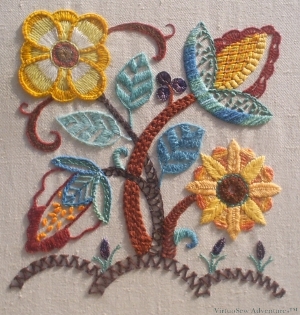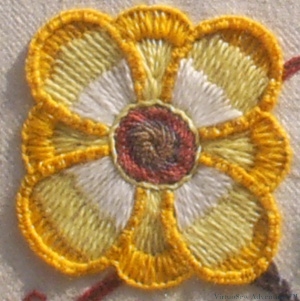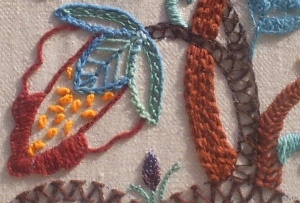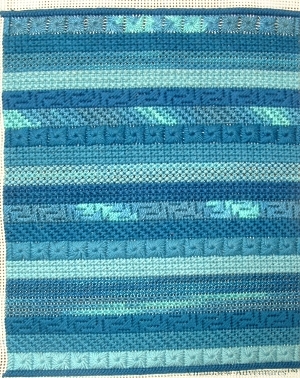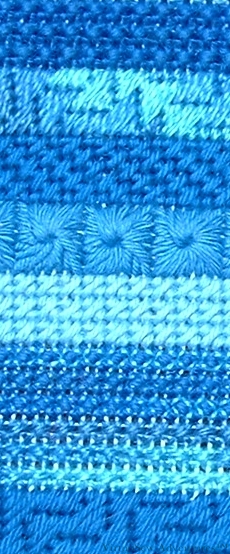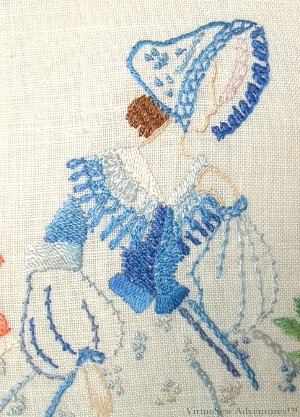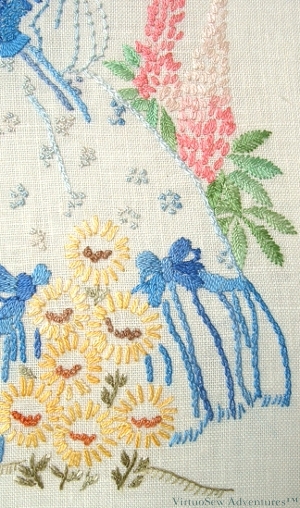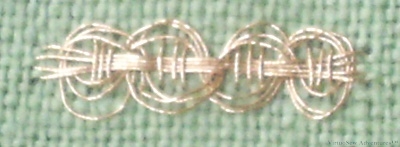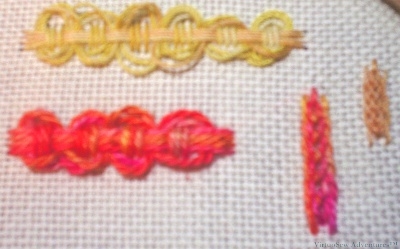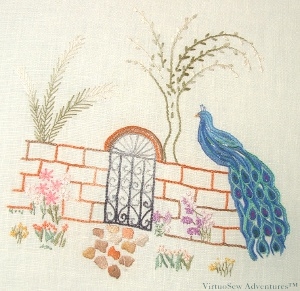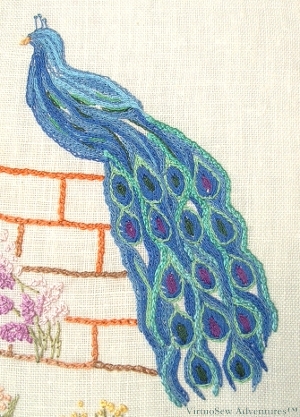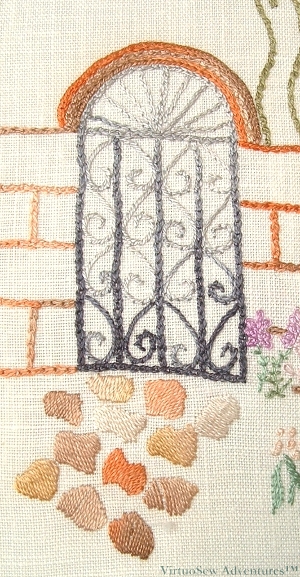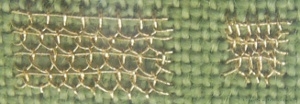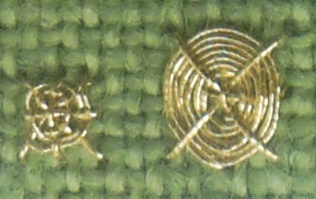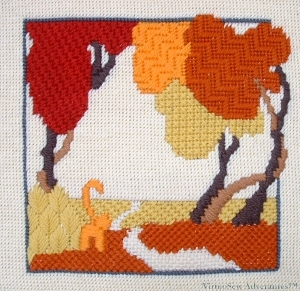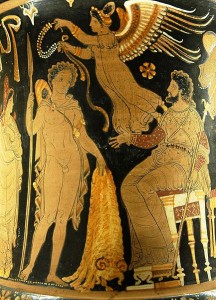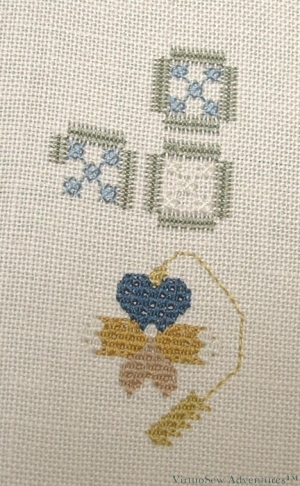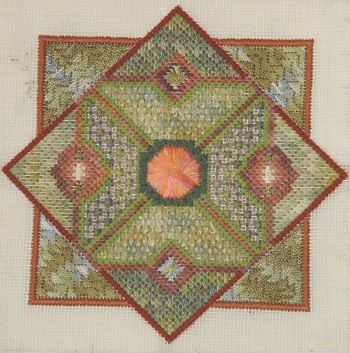Tag: stitches
Jacobean Work Panel
This design is from a transfer I picked up in a hurry a few years ago so as to have something to stitch while on holiday. It went swimmingly for a while and then ran into a brick wall and I have only just finished it.
The threads are wool and cotton, with a little bit of rayon. I intended the panel as a companion for my Jacobean Firescreen, so the colours of teal, brown and gold more or less chose themselves. There aren’t as many overdyed threads as I sometimes use, but that allows me to experiment all the more with the stitches.
Since I picked it up again, I’ve used it to play with some of the stitches which are new to me that I found in my copy of Yvette Stanton‘s Right Handed Embroiderer’s Companion. The whole thing became much more fun at that point!
So here, for example, the centre of the flower is worked in Spiral Trellis Stitch. I used a single strand, round thread overdyed in rust brown and purple, and although it was hair-raising to stitch, because I felt I was twisting myself in a spiral at the same time, I think it is rather successful. It’s not perfect, but I’ll do better another time, and I do think it looks rather good!
The dark brown rather lacy stem is worked in Mountmellick thorn stitch – another new one. Here I used one strand of a three-stranded cotton yarn. I think it would look better in a slightly heavier yarn, but it was fun to do and I will use this stitch again. The calyx of the strange fruit shows two of my favourite stitches – Cable Chain and Portuguese Knotted Stem.
I’m not entirely content with either of the flowers, but as I’m not sure why I shall leave well alone. Both of them have been unpicked at least twice, and I don’t want to wear out the fabric… Still, now it’s finished, I enjoyed working this!
Stripes!
This panel of canvaswork was originally intended to make a case for my husband’s beloved Psion palmtop computer. Alas, by the time I finished it, the Psion was no longer working.
The starting point was a wonderful Watercolours thread, graduated in shades of blue (not blue for a boy, blue for a redhead!), to which I added toning shades in soft embroidery cotton. It seems that this thread is not made any more, which I think is a pity. It used to provide a good alternative to tapestry wool, especially for those who don’t like working with wool in the summer, and – provided the right base fabric is chosen – a reasonable heavy but matte thread for surface embroidery. Almost all the threads now available are mercerised, and thus have a slight shine – but sometimes we don’t want any sheen on our stitches at all!
I rotated through several different stitches, as well as the different colours, and made sure that the second layer in the fine Wildflower thread overlaid a different base colour each time. There were five threads (Watercolours plus four soft cotton) and six stitches, which ensured that they cycled round. The stitches I chose were Milanese, Diagonal Mosaic, Eye (not pulled), Mosaic, Rice (using the Wildflowers thread for the second layer of stitches) and Double Cross Stitch.
The full size piece shows how the position of the colour changes is different in each stitch, as well as showing the veiled effect of different colours each overlaid by the variegated thread in the different panels of Rice Stitch. For that reason it is a very interesting needlepoint panel, but I still have a completely finished and neatly-worked canvaswork sampler looking for an occupation!
Did You But Hear My Lady..?
The Lady in the Garden, again came from a transfer, and was stitched as a companion to the Peacock, and a homage to Grandmama’s Lady. Unlike Grandmama, I made no effort to provide the lady with lovely graduated ruffles – if I am honest, because I really didn’t think I would finish them if I tried! Instead her dress is sprigged with flowers (in Sorbello stitch, which was rather fun!) and only ruffled around the hem.
Because I conceived of the Lady and the Peacock as a pair, I emphasised the flower colours around the lady, and worked some elements of her dress in one of the blues I used for the peacock.
The inside edge of the bonnet is ornamented with Rosette Chain stitch, while the outside is edged with closed feather stitch. This would also have been an ideal opportunity to use bonnet stitch, but I didn’t think of it in time! I also used Rosette Chain Stitch for the ruffles on the the lady’s collar. I like to use a variety of stitches – the trick is not to use so many that the eye becomes bewildered. Using a basic stitch and its variations is one way to maintain some sense of uniformity, as is keeping a small colour palette.
The bodice is in Bokhara Couching, and the sleeves outlined in coral stitch. I’m surprised at how well this works – it should look thorny, and heavy, but somehow manages to evoke an airy gauze sleeve. How does that work?
The bows above the flounce of the skirts are in satin stitch, and the impression of the flounce is given by lines of chain stitch. Almost all the visual weight of the dress is at the bottom, and the airy sprigging on the skirt allows the flowers to take some of the limelight.
Again the stitching is simple – fishbone stitch for the leaves, detached chain stitch and French knots for the flowers, and as almost all the threads were variegated, I got a lot of subtle – and not so subtle! – colour variation “for free” as it were.
I had already worked the Jacobean Fire Screen when I started work on the Peacock and the Lady, and was beginning to feel that I should do some more designing for myself. I will probably still use other designers’ work, because sometimes I want to concentrate on a particular thread or technique (as in the Tudor and Stuart Goldwork Masterclass) rather than the design. Besides, who knows what else I will find in the archives to write about!
The title of this post – for those who are scrabbling around in their memory – is the first line of “Silent Worship“, written by George Frederick Handel as an aria in his opera Tolomeo, but far more popular than anything else in it. Beware if you Google it – the last time I did so the first two links were for ringtones!
Tudor and Stuart Goldwork – Month Five Stitches
As I’ve mentioned, while I continue to persevere with the silkwork (there is a limit to how long I can stitch such fine work, even with the magnifier), I’m practising the goldwork stitches on a separate cloth. I don’t want the silk catching on metal threads while I’m working it, so the best way to avoid the problem is to do no metal thread work until the silk is finished. However, I couldn’t bring myself to ignore all the interesting stitches we are promised – hence the practice cloth.
I can see potential to use the Reverse Chain with Buttonhole Edging in the Amarna panels, since it creates a very complex impression when seen at real size, while not being all that difficult to stitch. It looks a lot like a braid or a filagree, so might be used to represent the necklaces that the Pharaoh gave to favoured courtiers at the Window of Appearances.
Guilloche stitch was an entirely different matter. It didn’t seem to matter what I tried, I couldn’t keep the crossing places of the final stage neatly under the long straight stitches, and the loops wouldn’t stay neat. In fact I even had a go in cotton threads, as you can see below.
The yellow is a mercerised cotton, while the orange is a fairly heavy pearl cotton. The Guilloche stitch seemed to work better in the heavy pearl cotton, which makes me wonder whether it is simply a matter of scale. The bulk of the pearl cotton makes the stitch so much more compact, whereas the gold thread on the practice cloth is much too fine for the spacing of the stitches. Note that the Reverse Chain with Buttonhole Edging looks much more braid-like with the finer, mercerised thread, where the pearl cotton almost looks like a different stitch. All of these stitches should also be easier when I’m working on the real piece which is resting on a floor frame. I’ll be able to use both hands to control the thread if necessary!
A Glamorous Peacock
I’ve only recently begun to design my embroideries entirely for myself. To begin with I took painted canvases or transfers and worked them using a variety of stitches and thread combinations, depending on what I had to hand and what aspect of embroidery was catching my attention at the time.
I was attracted by this transfer of a peacock a long time ago, in fact I think I bought it when I was still a teenager. If I had paid attention to my whims I would have bought a good many canvases and transfers of peacocks over the years. In fact there is a painted canvas that I didn’t buy that I now would, if I were to see it somewhere!
The fabric is a linen napkin, and the threads are a variety of silks bought when a needlework shop I worked in as a teenager closed. I got a very good discount, in gratitude for services rendered..
I didn’t actually get to begin stitching the Peacock until after I was married. He’s worked using chain stitch and heavy chain stitch, rows and rows and rows in blues and greens with a little purple in some of the eyes on his tail. I quite deliberately left some fragments unworked because it was beginning to feel rather congested, and although a peacock’s tail can look pretty bedraggled when it is closed, I wanted to bring to mind the glamour of the open tail and not the impediment of the closed one!
Now I look at the design again, it is worked almost entirely in chain stitch and chain stitch variations. The olive green tree is worked in twisted chain, with detached chain stitch leaves.
The brick work is outlined in ordinary chain stitch, and the arch includes cable chain stitch, which is one of my favourite surface embroidery stitches. It looks much harder than it really is, produces a line which is slightly more marked than ordinary chain stitch, and can be tweaked and ornamented with French Knots or simple seed stitches inside the links.
I tried to make as much use as possible of the variation of colour in some of the threads, so the work in this piece is done by the colour variation rather than by trying to make excessive use of stitch texture changes. It is now stretched and mounted over padding and framed without glass, so that the textures and colours have the best chance of being seen, and hangs in our spare room. Whether our guests notice it is altogether a different matter!
Tudor and Stuart Goldwork Masterclass – Month Four Stitches
While I continue to persevere with the silkwork, I am trying to keep up with the new stitches, practising on a separate cloth. In the case of the Detached Buttonhole stitch with Return, I think you can see that the fabric and the thread are not well matched, and so the structure is correct, but the appearance is not. The stitch should be much more closely worked, giving the impression of a fabric, not of a net. It’s tricky to be sure that the gold thread doesn’t kink back on itself in working this stitch, although this may be easier when I’m working on the real thing, using a slate frame on a stand, and therefore have both hands free to control the thread!
This second stitch is an Eight Spoked Flat Spider’s Web. It is very similar to the one in last month’s pair of stitches, but uses a foundation composed of a cross and an upright cross. I suspect it will be rather more stable than the four-legged version.
These “spot” stitches may come in very handy when I start thinking about some elements of the Amarna Panels.
I’m using a single type of thread for all these practise stitches. I don’t want to confuse myself with problems that may relate to an unfamiliar thread when I am already dealing with unfamiliar stitches! Still, already when I look down the row of stitches I’ve already tried, I see ideas for further experiments and even for applications of the stitches. This is what I hoped for when I joined the course, so I’m very happy with how it is going!
Canvaswork Inspired by Clarice Cliff
The design in counted cross stitch that I created, “The Cat Who Walked By Himself” (now being re-issued by Classic Embroidery – remember how excited I was a few months ago?) was such a success that I experimented with other ways in which the basic design might be used.
First of all, in ordinary tent stitch at a large size. Pleasant enough, but rather dull – for me, at any rate.
Then, at the same size as the original cross stitch, but using ornamental canvaswork stitches. Originally I had in mind to run classes based on these designs, in one of the local shops, but the shop closed, life changed direction, and I’ve not done anything with it yet.
As I post more of my early canvaswork, you will probably notice some stitches recur. For example, I like Upright Cross Stitch – it is sturdy and heavily textured – and Milanese stitch (I think just because I like the name). I usually sneak in Leaf Stitch as well (remember the Elephant of Considerable Charm?). I’ve also used Jacquard Stitch, and Satin Stitch. The background was worked in Encroaching Gobelin Stitch.
I’ve not put the heavy outlines on yet. Tapestry wool would be too heavy – some of the areas are quite small – but on the other hand, I don’t want to use something that will draw too much attention to itself by being shiny..
Planning The Golden Fleece
I know Janice suggested I should finish the Dreams of Amarna before getting wound up in The Golden Fleece, but I had a long train journey recently, and started idly thinking about the idea.
So:
Obviously, the scene to do is the one where Medea takes Jason into the grove where the Fleece is kept.. Lots of twisted branches and tree trunks, the sun sinking low in the west, and the Fleece glimmering in the light of the torches.
The first design challenge that occurs to me is that the Fleece will over dominate the picture if I am not careful with all that textured, gleaming gold. On the other hand, gold looks better with a dark, rich coloured background, so I can’t just settle for a daytime scene.
I can ease the problem slightly by dressing Jason and Medea in their best clothes, with rich colours and gold details, and perhaps rather than sunset, have it in moonlight (cue a silver kid moon!), with a line of torches to indicate the approach to the grove.
If I make sure that the Fleece has several shades of gold in it, that may also settle it more happily into place as only part of the panel..
There are several books I can use for reference – Tim Severin built a replica of the Argo and sailed and rowed from Greece to Georgia, which is where Colchis is thought to have been. Robert Graves wrote on the subject. I’ll have little trouble finding other references, either. We’re back to myths, legends, and archaeology…
Beginning the Tudor and Stuart Goldwork Masterclass
So now I am beginning to do the silk embroidery for the next Thistle Threads Online University Course, the Tudor and Stuart Goldwork Masterclass.
More gorgeous Au Ver A Soie silk thread to play with!
Furthermore, some new stitches! I’m not keen on counted work, so when I saw a chart in the instructions, my heart sank. Then I read the instructions and realised it was going to be a bit more fun than I had thought…
So, most of the silk stitching is to be in Queen Stitch, which I think I have done in canvaswork before, but never at this scale, and never changing its orientation or doing half queen stitches. The square motifs are bordered in Roman Stitch with Rice Stitch in the middle. Apparently in the historical pieces, Queen Stitches are often treated almost as pulled work, creating a lacy pattern of holes between the stitches. It’s quite difficult to pull tight enough, but as you can see from the navy blue petal, I’m beginning to get the hang of it.
The great attraction of this course for me is that we will have animations to show us the complex gold thread stitches that are the main focus of the course. At the end of the course, we’ll get a CD of these animations, so if I forget how to do one, I will be able to learn it again. Furthermore, some of Tricia’s recent posts on The Embroiderer’s Story mention that she has discovered some new stitches during her research trip and she is hoping to add them as a bonus!
The Canvaswork Knot Garden
This piece arose from my fascination with the knot gardens and parterres of early formal garden design.
It began with the octagonal Rhodes Stitch at the centre. I wanted to use the stitch, but not as part of a repeating pattern. In fact it proved much more difficult to get right than I was prepared for. I now can’t remember how many times I unpicked that wretched octagon!
From that central point a variety of little paths and beds radiate out, using slightly subdued colours again inspired in particular by the colours of herbs. The variegated threads are all from Stef Francis, pearl and soft cottons, and a chainette (in the corners). The stitches include Hungarian Stitch, cashmere stitch, and upright cross stitch (which for some reason turns up a lot in my canvaswork).
I realised that the interesting stitches I was using weren’t producing complete coverage of the canvas, but I decided not to worry about that, as I felt it might lead to something interesting.
As you can tell, what it has not yet lead to is a sensible finishing decision. I cannot for the life of me decide what to do with this. It would be a pity to put it under glass, as that wonderful raised boss of the octagon would lose all of its impact. At the same time, because the coverage is so varied, and because the octagon is such a vulnerable point, turning it into a cushion seems positively half-witted.
Take heed, and design your pieces with their end-use in mind!

